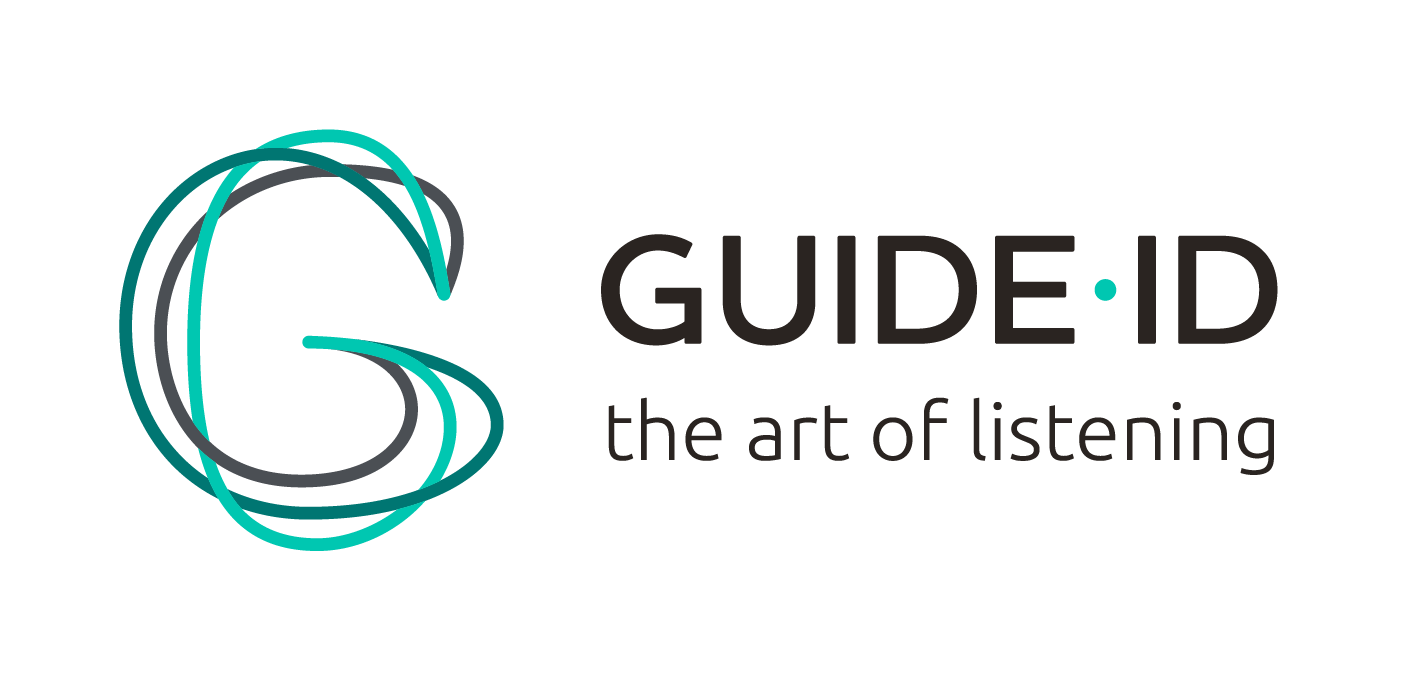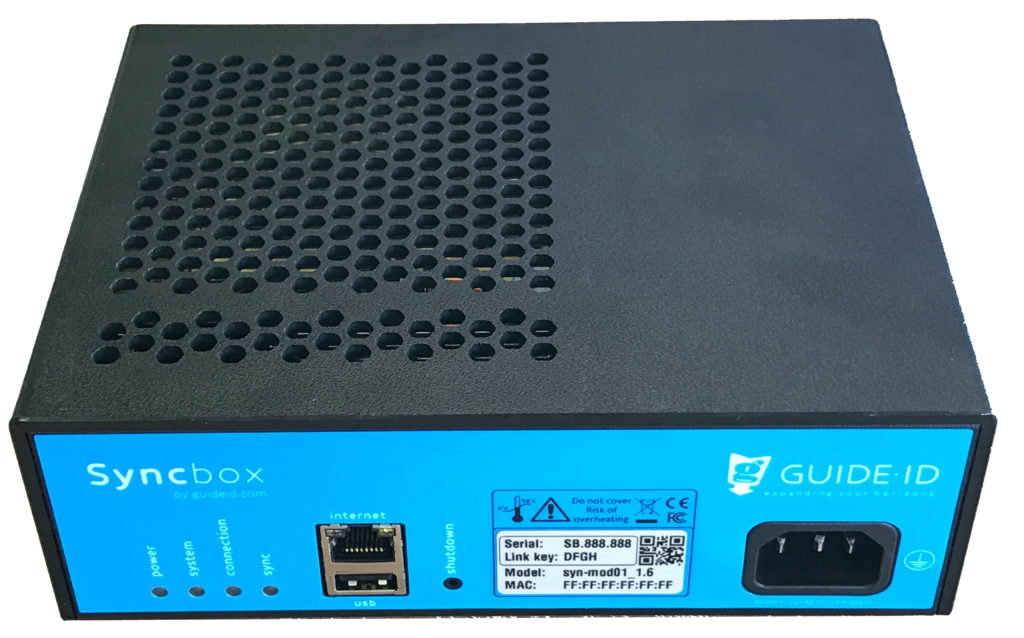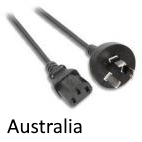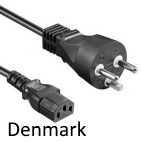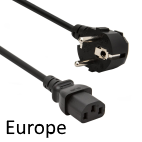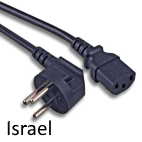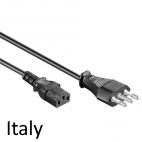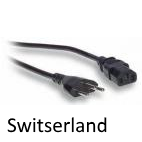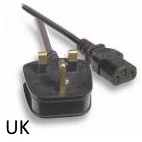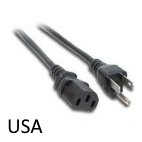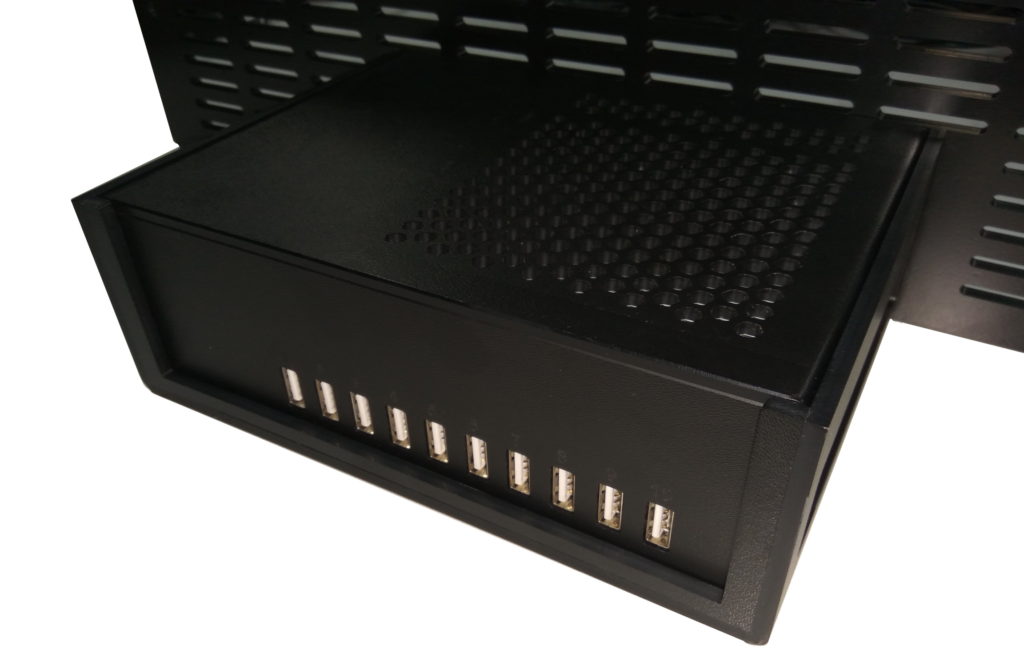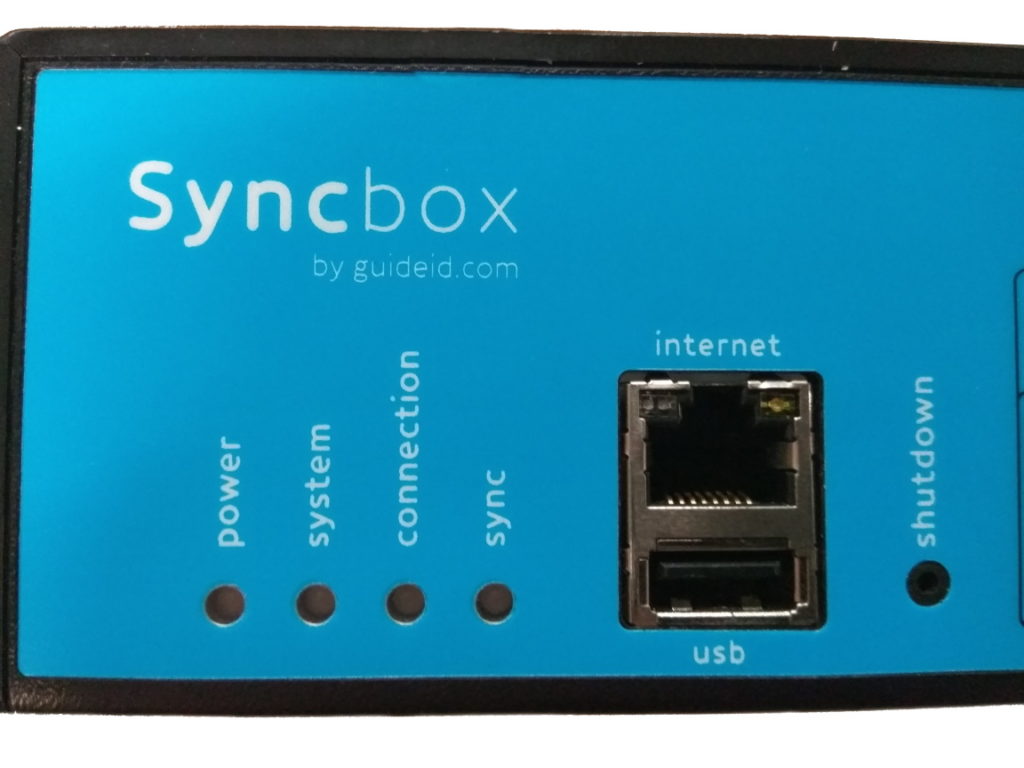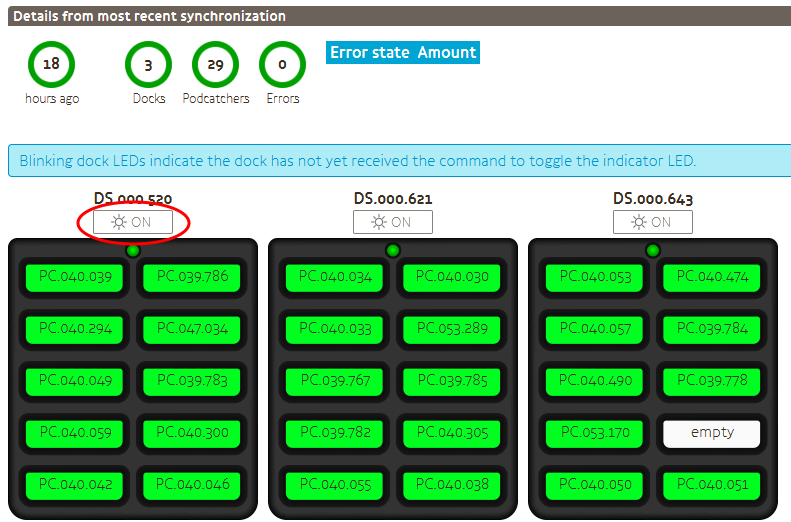1. General
1.1. Overview
The Syncbox is a compact computer, designed by Guide ID to charge and synchronize Podcatcher audio guides. You can connect up to 10 dockingstations (100 Podcatchers) to one Syncbox. If you have more Podcatchers on location you will need multiple Syncboxes.
1.2. Connections
The following connections are available:
- Power: 85 – 250 VAC, 47 – 63 Hz, 275 W, 1.2 A @ 230V (EU C14 connector)
- Ethernet: 100 MBit (RJ-45)
- USB front: 2.0 (type A)
- 10 x USB rear: 2.0 (type A)
1.3. Package contents
In the Syncbox packaging you should find:
- Syncbox
- AC Power cord, country specific
1.4. Safety instructions
The Syncbox is IEC 62368 certified. However the following safety requirements apply:
- Use the Syncbox only within the specified operating temperature range (0-50 C).
- Do not cover the ventilation openings. Risk of overheating.
- Use the provided AC power cable only.
- Connect AC cable to an earthed mains socket outlet or extension cord.
- Mains socket outlet must be easily accessible to allow disconnecting the cable.
- Ethernet port is intended for LAN connection installed wholly within the same building structure.
The Syncbox contains a Lithium-Ion battery (750 mAh, 3.7V, AA format). The battery is IEC 62133 certified.
Caution:
- Do not replace the battery. Risk of explosion if the battery is replaced by an incorrect type.
- Disposal of the battery into fire or a hot oven, or mechanically crushing or cutting of a battery, can result in an explosion.
- Leaving the battery in an extremely high temperature environment can result in an explosion or the leakage of flammable liquid or gas.
- Subjecting the battery to extremely low air pressure may result in an explosion or leakage of flammable liquid or gas.
1.5. Requirements
Important: The Syncbox must be connected to power and internet 24 hours per day, 7 days a week.
To connect the Syncbox you will need:
- Available power outlet (country specific AC Power cord is provided)
- Internet connection, by means of either:
- Ethernet cable or free socket (CAT5 or CAT6 standard)
- WiFi network (IEEE802.11n / g / b, 2.4 GHz bands)
1.5.1. Power
If power is removed, the Syncbox will continue on battery power for about half an hour. It will indicate this by beeping periodically. See Running on battery power.
1.5.2. Internet
If internet is disconnected, the Syncbox will remain functional for a maximum of 2 days. However contact with the Portal is not possible.
The internet connection has the following requirements:
- Fully functional internet access to websites (HTTPS).
- If you have multiple devices, a Router with DHCP is required. For multiple Syncboxes built into cabinets, a network switch is provided to make them share a single connection.
- If you have a firewall, outgoing access to HTTPS (TCP port 443) is required. The Syncbox uses only outgoing connections on that port. No port forwarding is required for incoming connections. Whitelisted domains should include:
- syncboxapi.guideid.com
- syncboxlogs.guideid.com
- syncboxdebug.guideid.com
- Using an Ethernet cable is recommended above using a WiFi network. Connecting the Syncbox to your WiFi network requires manual configuration. Please refer to advanced network configuration.
- Internet access through proxy servers is supported, but may require manual configuration. Please refer to advanced network configuration.
2. Installation
2.1. In a cabinet
- On the rear of the cabinet, remove the cabinet holder (2 screws)
- Place the Syncbox in the cabinet holder
- Guide the 10 dockingstation USB cables out of the cabinet, and connect them to the rear of the Syncbox (see Notes on USB cabling)
- Mount the cabinet holder (2 screws)
- Connect the Ethernet cable (or USB WiFi dongle, to the USB port combined with the Ethernet connector)
- Connect the Power cable
Note that when a cabinet is placed on top of another, cables may be guided internally as visible in the image below. In this case:
- Power cables are combined using a (European) extension cord. The extension cord is provided by Guide ID and has a country-specific power cord
- Ethernet cables are combined using a network switch, which is provided by Guide ID
2.2. Tabletop
- Place the Syncbox on a flat surface, not obstructing any of the ventilation holes
- Connect one or more Dockingstations to the rear of the Syncbox (see Notes on USB cabling)
- Connect the Ethernet cable (or USB WiFi dongle, to the USB port combined with the Ethernet connector)
- Connect the Power cable
2.3. Notes on USB cabling
In both installation cases, note that the following is required for USB cabling between the Syncbox and Dockingstation:
- USB Hubs are not supported. You cannot use them when connecting the Dockingstations to the Syncbox(es).
- Use the USB cables supplied with the Dockingstations. When using the Syncbox to charge the Podcatchers, these cables should be less than 1m in length.
- Do not use the front USB port. The Syncbox supports one Dockingstation on each of the 10 rear ports only.
To verify the cabling, after powering on the Syncbox please inspect the LED indicators on the Dockingstations. Lights should be white or green. See section Charging (5.3) for possible other LED colors.
3. Activation
The Syncbox must be activated before it becomes operational.
Notice:
- Important: you cannot use a Syncconsole and a Syncbox at the same time. If you are replacing your syncconsole(s) by a Syncbox make sure to delete the syncconsole(s) first.
- Beware that when switching from a Syncconsole to a Syncbox, all the published content will be re-synced on to the Podcatchers. This may take a while when you have a lot of content / multiple languages.
Activation steps:
- Power on the Syncbox by briefly pressing the ‘shutdown’ button
- A pen may be required to reach the button
- This is only required if the Syncbox was previously shut down using the button
- Open the Podcatcher Portal and login to your account
- Select the Sync module on the left
- Click the button “Add Sync Console”
- Select Syncbox as device type
- Fill in the details in the dialog. Both the Serial number and the Link key can be found on the label on your Syncbox
- Your Syncbox is now ready for use!
After activation, it may take a few minutes before the Sync now button becomes available.
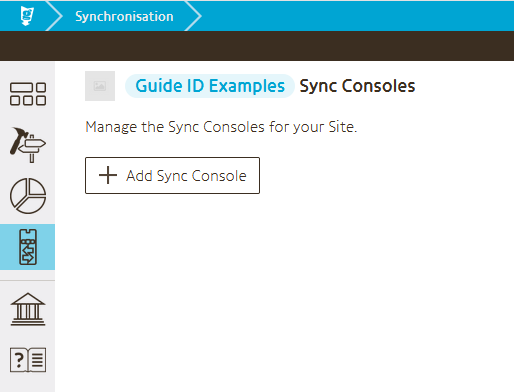
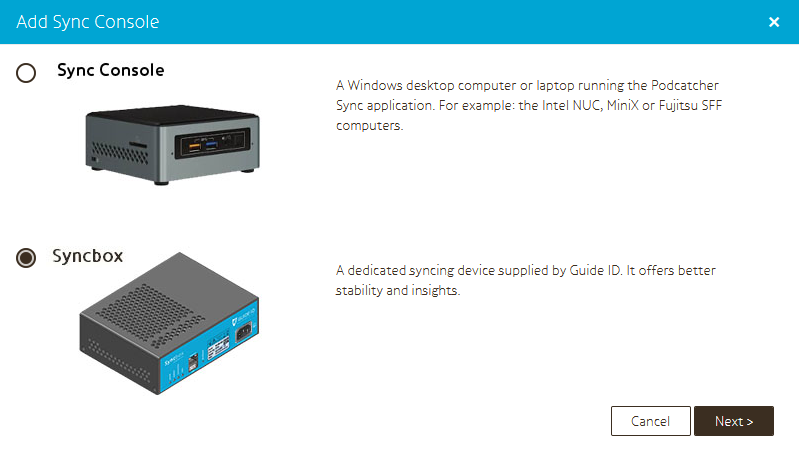
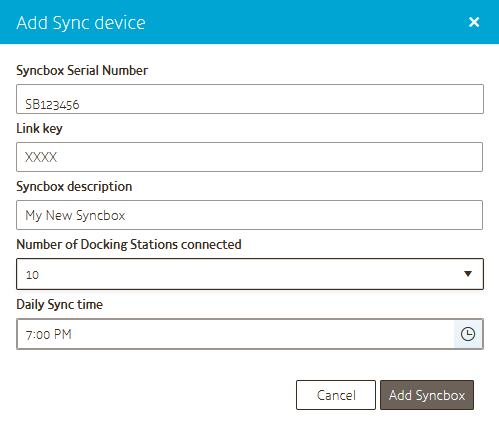
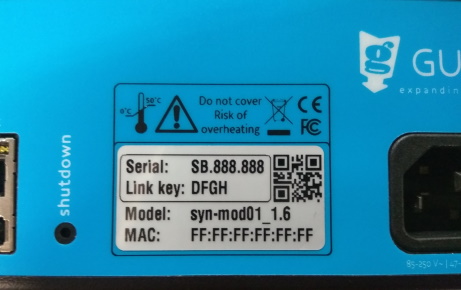
4. Usage
4.1 Power on
Briefly press the push button (labelled shutdown) to start the Syncbox, if it does not automatically switch on when power is connected. On power on the Syncbox will beep and switch on the system LED.
To verify that the Syncbox can connect to the Portal, please verify that the connection LED becomes green after connecting the Ethernet cable (or USB WiFi dongle). This can take a few minutes.
Note that when using WiFi, connecting the Syncbox to your WiFi network requires manual configuration. Please refer to advanced network configuration. Also please check this page if your network forces the use of a proxy server and does not support automatic configuration.
4.2. Service Podcatchers
Once connected and linked to your site, the Syncbox will automatically charge, synchronize and service your Podcatchers.
4.3. Shutdown for transport
When disconnected from power, the Syncbox will continue on battery power for a while. Before returning your Syncbox to Guide ID, please shut it down. In order to do so:
- Press the ‘shutdown’ button for 10 seconds, until the system LED starts flashing
- Wait until the system LED stops blinking
- If the Syncbox is placed in a cabinet block, make sure to disconnect the USB cables and to take the Syncbox out of the cabinet holder before sending the equipment back.
5. Troubleshooting
5.1. Lights
The Syncbox has 4 dual-color LED indicators. Each of the LEDs has a separate function. If all is well, all of them should be green or green blinking. Specific information can be found in the sections below.
5.1.1. Power
| Color | Blinking | Indication | Action required |
| off | – | No power, battery is empty or Syncbox switched off | Connect power, press push button |
| green | no | Power connected, battery full | – |
| orange | no | Power connected, battery charging | – |
| orange | yes | No power, battery discharging | Connect power |
| red | yes | Power connected, battery unable to charge | Contact support |
5.1.2. System
| Color | Blinking | Indication | Action required |
| off | – | System off | Connect power, press push button |
| green | no | System on | – |
| green | yes | System starting | Wait for startup |
| orange | no | System about to start | Wait for startup, or press button to cancel startup |
| orange | yes | System shutting down | If unexpected, contact support |
| red | no | System recovery mode | Contact support |
| red | yes | System overtemperature or boot error | Check temperature, if persistent contact support |
5.1.3. Connection
| Color | Blinking | Indication | Action required |
| off | – | No connection (no IP address) | Check Ethernet connection and DHCP server |
| green | no | Connected (inactive) | – |
| green | yes | Connected (active) | – |
| orange | no | Internet (not connected to Guide ID) | Check firewall |
| orange | yes | Connecting | Please wait for connection. This could take a minute. |
| red | no | Error authenticating | Contact support |
| red | yes | No internet | Check internet connection or firewall, or complete WiFi configuration when dongle connected |
5.1.4. Sync
| Color | Blinking | Indication | Action required |
| off | – | Sync disabled | Activate the Syncbox in the Portal |
| green | no | Sync finished successfully | – |
| green | yes | Sync running | – |
| orange | no | Sync scheduled | Wait for scheduled sync, or press button “Sync Now” in the Podcatcher Portal |
| orange | yes | Sync updating | Wait for update to complete |
| red | no | Sync finished with errors | Check dockingstation connections, replace faulty USB cables |
5.2. Sounds
5.2.1. System state change
When the Syncbox is started or restarted, a short beep sounds once.
5.2.1. System software updates
An automated restart can happen during a system software update. This will only occur if the Syncbox is idle. In the unlikely event of a failed software update and the Syncbox being unable to continue, a long beep will sound once and the System LED will turn red. It has then entered recovery mode, requiring service from Guide ID.
5.2.2. Running on battery power
If the Syncbox becomes unpowered due to a power dip or disconnection of the main cable, it switches to battery power and will remain running for about 30 minutes. A long beep will sound every 10 seconds during this time.
If the battery is completely depleted, the Syncbox will shut down.
Note that the Dockingstations will be disconnected from the power if the Syncbox becomes unpowered (also while it still runs on battery power). The light on the top of the dockingstations will be switched off and the Podcatchers will start blinking their orange light. Once power is restored, the Syncbox and the dockingstations will automatically resume operation.
5.2.3. Temperature range exceeded
If the Syncbox exceeds its operating temperature range, it will automatically shut down. A long beep will sound every 3 seconds during this time.
Once temperature is restored to within operational range, the Syncbox automatically resumes operation.
5.3. Charging
The Syncbox can supply power to Dockingstations through the USB cable. If Dockingstations are supplied with power, their LED on top should be green or white. If it is red, there is a problem with the connection between Syncbox and Dockingstation. Please refer to the notes on USB cabling.
Note that only newer Dockingstations support USB charging:
- Labelled Dockingstation 1.3. The Dockingstation version can be found on the bottom of the Dockingstation
- Serialnumber of DS.005.000 and higher. The Dockingstation serial number is shown in the Sync view in the Portal.
If the Dockingstation does not support USB charging, the DC adapter must be connected.

The table below lists possible dock LED indications.
| Color | Indication |
| off | Dockingstation is off |
| green | Dockingstation charging and operational |
| white | Dockingstation charging, not communicated yet |
| red | Dockingstation not charging |
| blue | Dockingstation locator function on (user request from Portal) |
5.4. Finding a Dockingstation
If there is a problem with a specific Dockingstation, it may be required to find out where in a cabinet it has been installed. Using the portal, the LED of a Dockingstation can be temporarily set to the color blue. To accomplish this:
- Check if the Dockingstation is hardware version 1.3 (supports USB charging). Please refer to section 5.3 to identify it. Dockingstation indication is not available on older hardware versions.
- Open the Sync overview in the portal.
- In section “Details from most recent synchronization”, beneath the Dockingstation serial, click the button labelled “ON”.
- Wait until the button stops blinking. It can take up to 3 minutes for the Dockingstation LED to become blue.
- The LED will remain blue for 15 minutes. You can optionally switch it off earlier using the same button on the portal. Note that again it can take up to 3 minutes for the Dockingstation LED to respond.
5.5. Helpdesk
If you have any questions, or require assistance with your Syncbox you can always contact our helpdesk.
See http://www.guideid.com/site/Contact on how to do so.
6. Frequently asked questions
6.1 Generic
- Is the Syncbox protected against theft of customer data?
The Syncbox utilizes encrypted SSL transfers only. Periodic security patches are installed. User data is encrypted in an secondary way.
- Will the Syncbox automatically power on after power loss?
The Syncbox will automatically power off when the battery is empty, and power on as soon as power is restored, unless it was switched off by the user using the push button.
6.2 ICT related
- Will we ever need console access to this machine?
No. The Syncbox is a standalone device without a keyboard or monitor (headless).
- Will GuideID or any 3rd parties have remote access to this machine?
No 3rd parties have access to the Syncbox. From our helpdesk, we have an option to enable remote access to the device. This will only be enabled if we need to service the device.
- Can the Syncbox be put in a guest VLAN to restrict access to my Intranet?
Yes. The Syncbox only requires access to the servers listed in the Further requirements section.
- Do we only need outbound internet access, no inbound NAT?
Correct. Please refer to the Further requirements section.
- My network forces the use of a proxy server. Does the Syncbox support this?
Yes, but manual configuration is required if the network does not support automatic configuration, for instance because credentials must be entered. Please refer to advanced network configuration.
- I have no Ethernet connection and have inserted a USB WiFi dongle. How to connect to my WiFi network?
Please refer to advanced network configuration, but note that not all WiFi dongles are supported, and can only be inserted in the USB slot combined with the Ethernet connector. Please only use the WiFi dongle supplied with the Syncbox.
